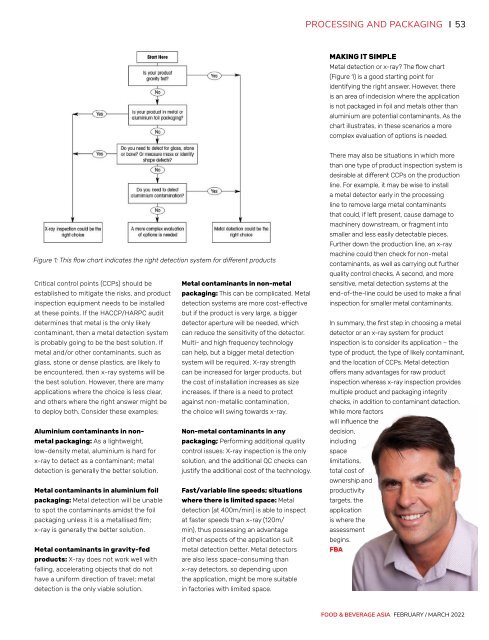Food & Beverage Asia February/March 2022
Food & Beverage Asia (FBA) is the leading source of food and beverage news in Asia since 2002. FBA delivers a comprehensive view of the food and beverage landscape, spanning across the latest health and nutrition trends and industry innovations in ingredients, recipe formulations, food science, sustainability, packaging, and automation, as well as advancements in agri and food-tech.
Food & Beverage Asia (FBA) is the leading source of food and beverage news in Asia since 2002. FBA delivers a comprehensive view of the food and beverage landscape, spanning across the latest health and nutrition trends and industry innovations in ingredients, recipe formulations, food science, sustainability, packaging, and automation, as well as advancements in agri and food-tech.
Create successful ePaper yourself
Turn your PDF publications into a flip-book with our unique Google optimized e-Paper software.
PROCESSING AND PACKAGING 53<br />
MAKING IT SIMPLE<br />
Metal detection or x-ray? The flow chart<br />
(Figure 1) is a good starting point for<br />
identifying the right answer. However, there<br />
is an area of indecision where the application<br />
is not packaged in foil and metals other than<br />
aluminium are potential contaminants. As the<br />
chart illustrates, in these scenarios a more<br />
complex evaluation of options is needed.<br />
Figure 1: This flow chart indicates the right detection system for different products<br />
Critical control points (CCPs) should be<br />
Metal contaminants in non-metal<br />
established to mitigate the risks, and product packaging: This can be complicated. Metal<br />
inspection equipment needs to be installed detection systems are more cost-effective<br />
at these points. If the HACCP/HARPC audit but if the product is very large, a bigger<br />
determines that metal is the only likely detector aperture will be needed, which<br />
contaminant, then a metal detection system can reduce the sensitivity of the detector.<br />
is probably going to be the best solution. If Multi- and high frequency technology<br />
metal and/or other contaminants, such as can help, but a bigger metal detection<br />
glass, stone or dense plastics, are likely to system will be required. X-ray strength<br />
be encountered, then x-ray systems will be can be increased for larger products, but<br />
the best solution. However, there are many the cost of installation increases as size<br />
applications where the choice is less clear, increases. If there is a need to protect<br />
and others where the right answer might be against non-metallic contamination,<br />
to deploy both. Consider these examples: the choice will swing towards x-ray.<br />
Aluminium contaminants in nonmetal<br />
packaging: As a lightweight,<br />
packaging; Performing additional quality<br />
Non-metal contaminants in any<br />
low-density metal, aluminium is hard for control issues: X-ray inspection is the only<br />
x-ray to detect as a contaminant; metal solution, and the additional QC checks can<br />
detection is generally the better solution. justify the additional cost of the technology.<br />
Metal contaminants in aluminium foil Fast/variable line speeds; situations<br />
packaging: Metal detection will be unable where there is limited space: Metal<br />
to spot the contaminants amidst the foil detection (at 400m/min) is able to inspect<br />
packaging unless it is a metallised film; at faster speeds than x-ray (120m/<br />
x-ray is generally the better solution.<br />
min), thus possessing an advantage<br />
if other aspects of the application suit<br />
Metal contaminants in gravity-fed metal detection better. Metal detectors<br />
products: X-ray does not work well with are also less space-consuming than<br />
falling, accelerating objects that do not x-ray detectors, so depending upon<br />
have a uniform direction of travel; metal the application, might be more suitable<br />
detection is the only viable solution.<br />
in factories with limited space.<br />
There may also be situations in which more<br />
than one type of product inspection system is<br />
desirable at different CCPs on the production<br />
line. For example, it may be wise to install<br />
a metal detector early in the processing<br />
line to remove large metal contaminants<br />
that could, if left present, cause damage to<br />
machinery downstream, or fragment into<br />
smaller and less easily detectable pieces.<br />
Further down the production line, an x-ray<br />
machine could then check for non-metal<br />
contaminants, as well as carrying out further<br />
quality control checks. A second, and more<br />
sensitive, metal detection systems at the<br />
end-of-the-line could be used to make a final<br />
inspection for smaller metal contaminants.<br />
In summary, the first step in choosing a metal<br />
detector or an x-ray system for product<br />
inspection is to consider its application – the<br />
type of product, the type of likely contaminant,<br />
and the location of CCPs. Metal detection<br />
offers many advantages for raw product<br />
inspection whereas x-ray inspection provides<br />
multiple product and packaging integrity<br />
checks, in addition to contaminant detection.<br />
While more factors<br />
will influence the<br />
decision,<br />
including<br />
space<br />
limitations,<br />
total cost of<br />
ownership and<br />
productivity<br />
targets, the<br />
application<br />
is where the<br />
assessment<br />
begins.<br />
FBA<br />
FOOD & BEVERAGE ASIA FEBRUARY / MARCH <strong>2022</strong>


















